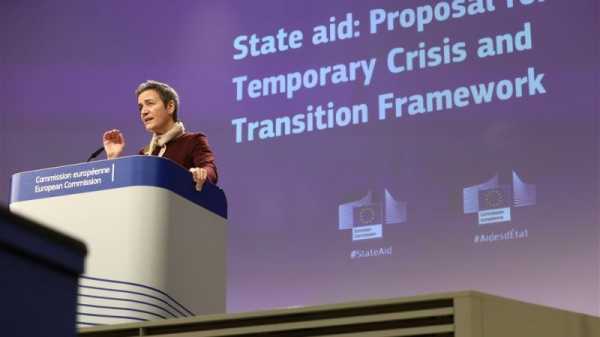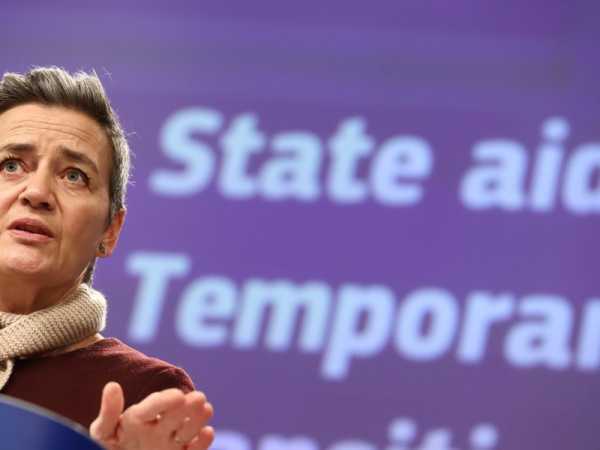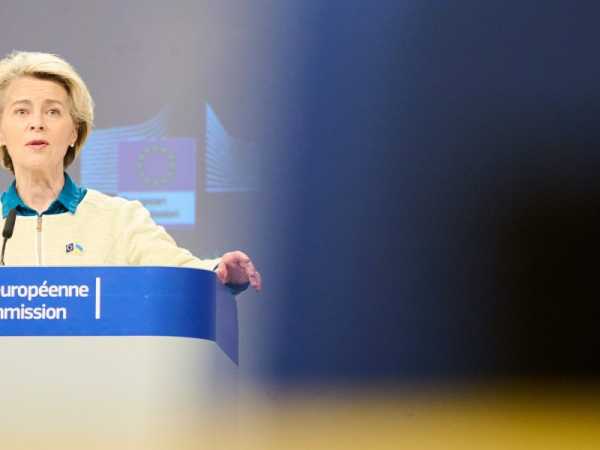
Just days after the Commission presented its new Green Deal Industrial Plan to counter foreign subsidies for clean industry, a leaked Communication details the full extent of the temporary bending of state aid rules across the bloc, including a rule to prevent a German go-alone.
On Wednesday (1 February), European Commission President Ursula von der Leyen presented the new green industrial plan, launched in reaction to the US Inflation Reduction Act (IRA) which provides $369 billion in subsidies for clean industry.
While most of the plan was unveiled in the EU competition chief Margrethe Vestager’s consultation plans earlier this week, details over the functioning of ‘matching subsidies’ were long awaited.
The new rules are designed to boost member states’ capacities to incentivise industries to stay in Europe in the face of large foreign subsidies “in sectors strategic for the transition towards a net-zero economy”, the document reads.
The Communication relates to the Temporary Crisis and Transition Framework, one of the pillars of the Green Deal Industrial Plan.
The leaked document, labelled ‘sensitive’ and seen by EURACTIV, intends to “specify the criteria for the assessment of the compatibility with the internal market of State aid measures”.
Waving goodbye to ‘technology neutrality’
The Communication confirms the Commission’s intention to enable ‘matching subsidies’, whereby the EU can match a subsidy offer a company receives from a country outside of Europe – in order to prevent the company from moving abroad.
As the proposal limits those sectors to the production of “batteries, solar panels, wind turbines, heat-pumps, electrolysers and carbon capture usage and storage (CCUS) as well as related critical raw materials”, it marks a departure point from the Commission’s previous stance of ‘technology neutrality’.
To be eligible for the support, member states would need to prove that without it, there’s a risk of such production sites leaving Europe or being built elsewhere.
“Before granting the aid, the granting authority must verify the concrete risks of diverting the productive investment outside the EEA [European Economic Area] and that there is no risk of relocation within the EEA,” the document reads.
Except for in exceptional circumstances, this support should not exceed €100 million for richer areas and €300 million for poorer regions, termed “assisted areas designated in the applicable regional aid map”, the paper reads.

EU's Vestager warns of fragmentation risks, but expands state aid
On Wednesday (1 February), Margrethe Vestager presented a new framework for state aid that will allow member states to subsidise more companies for longer, while also warning that such subsidies were a threat to the integrity of the single market.
Matching foreign subsidies, but no go-alone for Germany
However, the Commission can approve even higher support than that on a case-by-case basis for projects within poorer regions – those with a GDP of less than 75% of the EU average – or those which are spread across several EU countries.
This would be conditional on the company proving that they would receive the same amount of support outside the EU, such as under the US IRA.
In those cases, the document says, the Commission could approve “an increased aid amount, maximum up to the amount of subsidy available for an equivalent investment in a third country jurisdiction”.
Such “matching” of foreign subsidies was a key demand by France and Germany in a paper published last December.
However, since Germany does not have any regions which fall under the poorer category, it could only match subsidies above €100 million together with other EU countries.
Critics have warned that such an option could open the door for profit-grabbing by companies pitting countries against each other in a global race to grab the highest subsidies available.
Vestager’s proposal aims to avoid this by conditioning that state aid should not exceed the bare minimum to make the production site “sufficiently profitable”, the document reads, adding that this can be measured using “methods that are standard practice in the given industry”.
“The profitability of the project is to be compared with normal rates of return applied by the beneficiary in other investment projects of a similar kind,” a footnote reads.
At the same time, state aid should only cover up to 10% of total investment costs, with some substantial options of additional support in the case of poorer regions, small and medium-sized companies and in the case that the support is granted as tax breaks.
“Under no circumstances may the total aid amount exceed 100% of the [total investment] costs,” the document reads, hinting that this was a realistic concern of Commission staff.

In defence of the European single market
The EU’s greatest strength in competition with the US and China is its single market, and if state aid regulations are permanently loosened, it will be undermined, write Piotr Arak and Konrad Szymański.
Ramp up investments for climate neutrality
The leaked Communication is, in many ways, in line with the Temporary Crisis Framework that is currently in application.
Under the new rules, aid up to €2 million per undertaking per member state can be granted, as long as this financial help comes no later than 31 December 2023. The aid can take the form of direct grants, tax and payments advantage, the document reads.
On top of these rather ‘standard’ aid measures, further help can be given to companies severely hurt by the explosion in energy prices, and projects intending to further the EU’s efforts towards carbon neutrality.
To help companies weather the high energy prices, the support must be granted “on the basis of either their current or historical energy consumption” – all the while maintaining incentives, financial or otherwise, to stray away from gas usage, which has run low after Russian taps were closed. This is also made available only up to 31 December 2023.
In the context of investments dedicated to the production of energy by renewable sources, the framework differentiates between mature technologies like solar, wind, and hydropower, and less mature technologies.
The amount and nature of the aid has to be determined by a competitive bidding process in mature technologies. For less mature technologies, however, the amount can be administratively set by member states, on the basis of the cost of each presented project, but it cannot exceed 45% of total investment costs.
In practice, this means that technologies that are more experimental, or in their infancy, can benefit from more easily-accessible cash from their respective administrations.
Similar types of additional aid can be granted to projects that aim to decarbonise energy-intensive industries, and companies’ efforts to reduce electricity consumption altogether.
For some of the aid referring to renewables and green industries, the Communications prolongs the applicability of the Framework up to 31 December 2025.
The document was leaked days before an informal meeting of competitiveness ministers on Tuesday (7 February), during which state aid rules will be addressed.
“I do not expect ministers to want to go into the fine details, but there will be a strategic discussion,” a Swedish presidency official said in a brief.
“It will be very hard to find common grounds among Member States”, he added.
Kira Taylor and János Allenbach-Ammann have contributed to the reporting.
[Edited by Nathalie Weatherald]

EU’s green industrial plan vague on clean tech, finance, critics say
The Commission’s ‘Green Deal Industrial Plan’, unveiled on Wednesday (1 February), promises simplified EU regulation for clean technologies, but critics say it lacks clarity and opens the door to unrestricted subsidies in France and Germany until the end of 2025.
Source: euractiv.com



